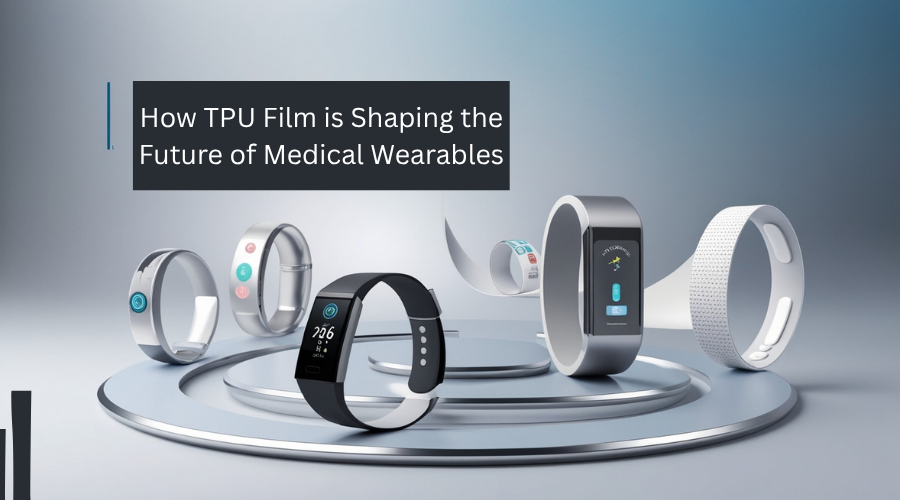


In today’s tech-savvy world, medical wearables are redefining how we monitor, diagnose, and manage health conditions. From smart patches that track glucose levels to remote ECG monitoring systems, these devices are bringing healthcare closer to patients—often quite literally—right onto their skin.
But behind the scenes of these high-tech innovations is a critical material that makes it all possible: TPU film, or Thermoplastic Polyurethane film.
Let’s take a deep dive into how this flexible, durable, and skin-friendly material is shaping the future of medical wearables—and why its importance is only set to grow.
TPU (Thermoplastic Polyurethane) is a class of plastic materials known for their flexibility, durability, and resistance to abrasion, chemicals, and oils. TPU film is essentially a thin, elastic sheet made from this polymer, and it can be transparent, colored, or textured depending on its intended application.
Unlike rigid plastics, TPU film remains soft and stretchable, making it an ideal candidate for use in wearables that need to adhere closely and comfortably to the human body.
Medical wearables must meet a strict set of requirements: biocompatibility, comfort, breathability, and reliability. TPU film ticks all these boxes—and then some.
One of the most significant concerns in medical wearables is ensuring the material does not cause skin irritation, allergic reactions, or discomfort. TPU films are hypoallergenic and safe for prolonged skin contact, making them an excellent choice for devices like:
• Glucose monitors
• Smart bandages
• ECG patches
• Remote temperature sensors
You might think it’s impossible to have a material that lets air pass through but keeps moisture out. TPU film does just that. Its micro-porous structure can be engineered to allow the skin to breathe while preventing sweat and external moisture from interfering with the device.
This feature is especially vital in medical settings, where hygiene and comfort go hand in hand.
Nobody wants to wear a bulky or rigid device all day. With wearable TPU film, medical gadgets can remain ultra-thin and stretchable, adapting to the natural movements of the body. Whether it’s wrapped around a joint, chest, or wrist, TPU conforms without restricting mobility.
TPU film can be made crystal clear, allowing for discreet wearables that blend into the skin or clothing. This opens the door for medical devices that are not only functional but also visually appealing, which is crucial for patient adoption and long-term use.
Let’s explore how TPU film is already revolutionizing the medical wearables space and hinting at what’s coming next.
TPU film is used in smart bandages embedded with sensors to monitor wound healing, detect infections, or deliver medication. The film ensures the bandage stays securely attached, protects the area, and feels comfortable during healing.
For diabetics, CGMs offer life-changing convenience by continuously tracking glucose levels. TPU film acts as the skin-facing layer, ensuring comfort and long wearability while safeguarding sensitive internal components.
Wearable ECG patches allow for heart monitoring at home instead of at the hospital. TPU’s electrical insulation properties and soft touch ensure accurate signal transmission and user comfort.
TPU films help encapsulate and protect temperature sensors, especially those designed for infants or the elderly, where skin sensitivity is a major concern.
The future of medical wearables is not just about smaller sensors or faster connectivity—it’s also about materials innovation. Here's how TPU film will continue to be a game-changer:
Researchers are developing wearable electronics that integrate sensors into everyday clothing. TPU films can be laminated onto fabrics to serve as both a protective and functional layer, offering moisture resistance while housing circuitry.
Biosensors that detect biomarkers in sweat or tears require materials that are not just sensitive but biocompatible and stable under various conditions. TPU film's chemical resistance and clarity make it ideal for transparent, disposable biosensors.
With increased focus on sustainability in healthcare, TPU film has another ace up its sleeve: it’s recyclable. Future medical wearables could become more eco-friendly by using bio-based TPU films, reducing both patient waste and environmental impact.
To fully appreciate the power of TPU film, let’s compare it with some alternatives:
|
Property |
TPU Film |
Silicone |
PVC |
Polyethylene |
|
Biocompatibility |
✅ High |
✅ High |
❌ Moderate |
❌ Low |
|
Flexibility |
✅ High |
✅ High |
❌ Low |
✅ High |
|
Breathability |
✅ Yes |
❌ No |
❌ No |
❌ No |
|
Waterproofing |
✅ Yes |
✅ Yes |
✅ Yes |
✅ Yes |
|
Recyclability |
✅ Yes |
❌ No |
❌ No |
✅ Limited |
Clearly, TPU film offers the most balanced profile, especially when used in wearables meant for long-term contact and disposable use.
Despite its many strengths, using TPU film in medical wearables comes with a few considerations:
• Heat Sensitivity: TPU can deform under high temperatures, so manufacturing processes must be carefully controlled.
• Cost: Premium-grade TPU film, especially medical-grade types, can be more expensive than alternatives.
• Adhesion Compatibility: Proper bonding with electronics and other device layers requires specific adhesives or lamination techniques.
Still, these challenges are far outweighed by the benefits, and ongoing research is addressing these limitations rapidly.
Conclusion
As medical wearables become more advanced and integrated into our daily lives, TPU film is quietly but powerfully enabling this transformation. Its unique combination of comfort, safety, flexibility, and performance makes it the material of choice for next-gen health monitoring devices.
Whether you're a healthcare innovator, a device manufacturer, or simply a curious consumer, understanding the value of TPU film will give you deeper insight into the tech that's helping shape the future of healthcare—one patch, one sensor, one wearable at a time.
Why does the Correct Film Material mean a lot?
READ FULLIn today’s tech-savvy world, medical wearables are redef
READ FULLTPU know with its chemical name of Thermoplastic Polyurethane, is a
READ FULL